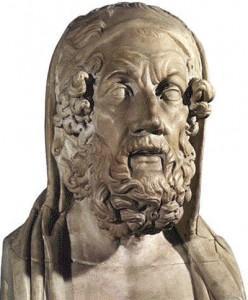Argos History
Homer's Iliad (written 800 B.C.E.) The men of Argos, again, and those who held the walls of Tiryns, with Hermione, and Asine upon the gulf; Troezene, Eionae, and the vineyard lands of Epidaurus; the Achaean youths, moreover, who came from Aegina and Mases; these were led by Diomed of the loud battle-cry, and Sthenelus son of famed Capaneus. With them in command was Euryalus, the godlike man, son of king Mecisteus, son of Talaus; but Diomed was chief over them all. With these there came eighty black ships.

Argos city was named after its first King, Argos, son of Zeus and his first mortal wife, Niobe. Ancient myths have it that Argos was the first to teach Greeks the cultivation of wheat, with seeds he had brought from Libya. A proof of this comes from Homer, who called the Argolis Plain a Libyan Plain. An alternative etymological approach is that Argos comes from the Greek root arg-, =bright, shining, luminous (compare to Greek argyros and Latin argentum = silver). Already in Iliad, Argos is described as the kingdom of Diomed, and it was he who led his soldiers all the way to Troy. Bronze Age Argos was, together with Mycenae and Tiryns, ruling the plain of Argolis.
From the beginning of Archaic Times (c. 800 B.C.) and through to Classical Times, Argos was one of the most prominent city-states, together with Athens, Sparta and Corinth. Around the beginning of the 5th century B.C., Sparta invaded Argolis and Argos was captured. Yet, although not a strong military power any longer, the Argives continued to excel in Arts. One of the most impressive monuments of the Hellenistic period in Argos was its Theater, on the southwest slopes of the Acropolis of Larissa, in direct neighborhood with the city's Agora. Later on, in Roman times, extensive alterations to its theater, one of the biggest ones in Greece, if not the biggest, show a continuance in the city’s cultural life.
During the first millennium A.D., Argos in particular, and Argolis in general, must have shared the hard times of attack, plunder, enslavement, devastation and depopulation with the rest of the Peloponnese, due to continuous aggression by nomad tribes. Until this violent infiltration came to an end, it was a continuous source of destabilization of the social and economic structure in the Peloponnese and elsewhere, despite the efforts of the central Byzantine authorities. No question for any civilization advances, except for building of churches and Monasteries.
Later on, when West Europe declared war on the Muslim World and Crusaders, with various intentions, flooded the East, Frankish and Venetian occupation of Greece and of the rest of the Byzantine Empire meant the transition from plunder and submission to barbarian tribes to a very well organised feudal type of exploitation. This was not gladly accepted by the local population, but they should have known better, because, when it was succeeded by Ottoman Asian despotism, the latter proved unbearable.
When Franks established their rule in Greece, they followed the same pattern as in the rest of Europe, i.e. by building castles on the nearby hills in practically every village, city, or port of importance. This could hardly create the European Burg type of settlement, but it gave protection to the occupation forces. Only at a small number of places was a real “burg” settlement created, such as Mesta Village on Chios, for example, or the Old city of Rhodes. Needless to say, all of these fortifications were erected at the expense of the ancient acropoleis (=plural to acropolis) that were still proudly standing on top of the hills nearby all ancient cities of Greece. It has been said that if today we are happy to have the ruins of the Acropolis of Athens almost intact, this is thanks to the fact that Athens was a completely insignificant (to Frankish and Venetian interests) village in the Middle Ages and later; otherwise we would have a monstrous wall enclosure right in the middle of modern Athens!
So, in the 12th century, a castle on Larissa hill was built. Argos was under the Franks and the Venetians until 1463. Then it was the Turks’ turn; they ruled Argos until 1686, when Argos fell again to the Venetians, under Morosini, being held until 1716. From then and until the Greek War of Independence in 1821, it was ruled by the Turks. |
|



